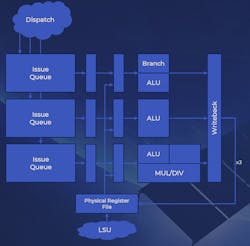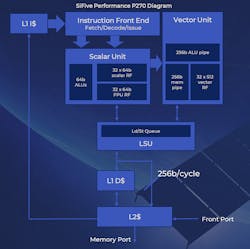SiFive Deepens RISC-V Core Lineup
This article is part of TechXchange: RISC-V: The Instruction-Set Alternative
SiFive keeps cranking out new versions of its RISC-V cores. Its two most recent additions include the Performance P550 core and the Performance P270 vector core, which target high-performance computing applications. The P550 delivers a SPECInt 2006 score of 8.65/GHz, comparable to other high-end application processors.
The company’s cores are supported by a range of silicon foundries as well as a number of FPGA platforms. One of the latest additions to the mix is Intel’s foundry.
Amber Huffman, Intel Fellow and CTO of IP engineering group at Intel, says, “We are pleased to be a lead development partner with SiFive to showcase to mutual customers the impressive performance of their P550 on our 7-nm Horse Creek platform. By combining Intel's leading-edge interface IP such as DDR and PCIe with SiFive's highest-performance processor, Horse Creek will provide a valuable and expandable development vehicle for cutting-edge RISC-V applications"
The Performance P550 utilizes a 13-stage, triple-issue, out-of-order pipeline compatible with the RISC-V RV64GC ISA (Fig. 1). It’s based on the SiFive U84 microarchitecture. Each core has its own L1 and L2 cache.
The P550 can be delivered in a cluster of up to four cores (Fig. 2). This quad-core complex uses about the same silicon area as one Arm Cortex-A75 core, thus offering a significant performance-per-area advantage. Keep in mind the area aspect.
The Performance P270 is built around an 8-stage, dual-issue, highly efficient in-order pipeline with a 256-bit vector unit (Fig. 3). It’s compatible with the RISC-V RV64GCV ISA and can deliver a SPECInt 2006 score of 4.6/GHz. While the P550 fits in 0.38 mm2, the P270 requires only 0.175 mm2. The P270 also be arranged in a multicore configuration.
About the Author
William G. Wong
Senior Content Director - Electronic Design and Microwaves & RF
I am Editor of Electronic Design focusing on embedded, software, and systems. As Senior Content Director, I also manage Microwaves & RF and I work with a great team of editors to provide engineers, programmers, developers and technical managers with interesting and useful articles and videos on a regular basis. Check out our free newsletters to see the latest content.
You can send press releases for new products for possible coverage on the website. I am also interested in receiving contributed articles for publishing on our website. Use our template and send to me along with a signed release form.
Check out my blog, AltEmbedded on Electronic Design, as well as his latest articles on this site that are listed below.
You can visit my social media via these links:
- AltEmbedded on Electronic Design
- Bill Wong on Facebook
- @AltEmbedded on Twitter
- Bill Wong on LinkedIn
I earned a Bachelor of Electrical Engineering at the Georgia Institute of Technology and a Masters in Computer Science from Rutgers University. I still do a bit of programming using everything from C and C++ to Rust and Ada/SPARK. I do a bit of PHP programming for Drupal websites. I have posted a few Drupal modules.
I still get a hand on software and electronic hardware. Some of this can be found on our Kit Close-Up video series. You can also see me on many of our TechXchange Talk videos. I am interested in a range of projects from robotics to artificial intelligence.




